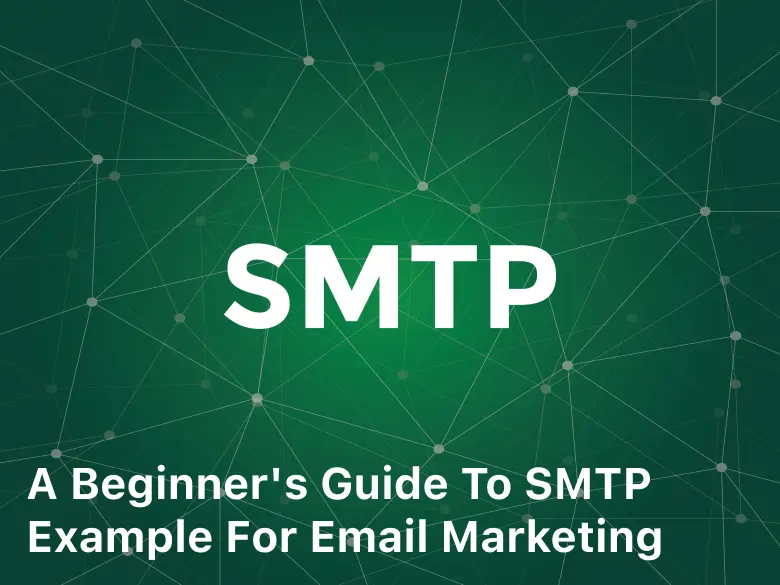A Beginner’s Guide To SMTP Example For Email Marketing
A Beginner’s Guide To SMTP Example For Email Marketing – Are you new to email marketing and wondering how SMTP works? This comprehensive guide will walk you through SMTP examples for email marketing, demystifying the process step by step.
In the ever-evolving landscape of digital marketing, email marketing remains a stalwart tool for businesses to connect with their audience effectively.
It’s an art, really, blending the right message with impeccable timing, and ensuring your emails not only reach their intended recipients but also engage them.
One crucial aspect of email marketing that plays a pivotal role in this process is SMTP, or Simple Mail Transfer Protocol. In this comprehensive guide, we will delve into the world of SMTP, breaking down its key components, and providing real-world examples to help you harness the power of email marketing and outrank your competitors.
What is SMTP?
SMTP, or Simple Mail Transfer Protocol is the backbone of email communication. It is the set of rules that governs the way emails are sent and received across the vast expanse of the internet.
SMTP ensures that your email, be it a newsletter, a promotional offer, or a personalized message, reaches its intended destination, reliably and efficiently.
The SMTP Process
SMTP operates behind the scenes, seamlessly handling the transmission of emails from your email client or server to the recipient’s email server. It involves several steps, such as:
- Establishing Connection: When you hit send on your email client, it connects to your email server, which, in turn, establishes a connection with the recipient’s email server.
- Authentication: SMTP servers often require authentication to verify the sender’s legitimacy, preventing spam and unauthorized access.
- Message Transfer: The email is then transferred from your server to the recipient’s server. This step includes various checks to ensure the email’s integrity.
- Delivery: Once the recipient’s server receives the email, it’s either delivered directly to the recipient’s inbox or placed in a queue for further processing.
- Bounces and Errors: If any issues arise during the process, such as an invalid email address, the SMTP server generates bounce-back messages to inform the sender.

The Basics of SMTP
To grasp the concept fully, let’s break down the fundamental elements of SMTP:
- SMTP Server Configuration
Before you embark on your email marketing journey, you must configure your SMTP server. This involves specifying critical details, such as the server’s address, port, and authentication information. By doing so, you provide your email client with the necessary information to effectively send your messages.
- Composing Your Email
Once your SMTP server is configured, you can begin composing your email. This is where your creativity comes into play. You can write your message, add recipients, craft compelling subject lines, and attach any necessary files. Your email client then prepares this message for sending.
- Handing It Over to SMTP
When you click that “Send” button, your email client transfers the message to the SMTP server, which takes over the process. SMTP works tirelessly behind the scenes to ensure your email reaches its intended destination.
- SMTP in Action
SMTP is akin to a skilled courier, connecting with the recipient’s email server. It communicates with this server, validates recipient addresses, and successfully transfers your message. This process repeats until your email finally arrives in the recipient’s inbox.
SMTP Example For Email Marketing
Now, let’s put theory into practice by exploring a real-life SMTP example within the context of email marketing:
Step 1: Building Your Subscriber List
Imagine you’ve embarked on an email marketing campaign, and you’ve compiled a list of eager subscribers. This list includes their email addresses and other pertinent details, setting the stage for your outreach.
Step 2: Crafting Your Compelling Email
With your subscriber list ready, it’s time to create an engaging email. Whether you’re sending out a newsletter, announcing a new product, or simply sharing valuable content, crafting an appealing message is key.
Step 3: Fine-Tuning SMTP Configuration
To ensure smooth delivery, you need to configure your SMTP server with precision. Here are the essential details:
- Server Address: smtp.yourdomain.com
- Port: 587
- Authentication: Yes (Username and Password)
Step 4: Initiating Email Dispatch
With your SMTP server poised for action, your email client takes charge and dispatches the message using SMTP. The SMTP server manages the intricate delivery process, ensuring your email finds its way to the recipients.
Step 5: Inbox Arrival
Finally, your carefully crafted email arrives in your subscribers’ inboxes, ready to be read and acted upon. You’ve successfully harnessed SMTP for email marketing.
Here’s a simple example of how to send an email using the Simple Mail Transfer Protocol (SMTP) in Python. In this example, we’ll send a basic text email using the smtplib library.
import smtplib
from email.mime.text import MIMEText
# Email configuration
sender_email = ‘your_email@gmail.com’
recipient_email = ‘recipient@example.com’
subject = ‘Hello, SMTP!’
message = ‘This is a test email sent via SMTP.’
# Create the email message
msg = MIMEText(message)
msg[‘Subject’] = subject
msg[‘From’] = sender_email
msg[‘To’] = recipient_email
# SMTP server configuration for Gmail
smtp_server = ‘smtp.gmail.com’
smtp_port = 587
smtp_username = ‘your_email@gmail.com’
smtp_password = ‘your_email_password’
# Create an SMTP connection
try:
server = smtplib.SMTP(smtp_server, smtp_port)
server.starttls()
server.login(smtp_username, smtp_password)
# Send the email
server.sendmail(sender_email, recipient_email, msg.as_string())
# Close the server connection
server.quit()
print(‘Email sent successfully’)
except Exception as e:
print(‘Email could not be sent. Error:’, str(e))
Common Questions
Now, let’s address some common queries that often arise when dealing with SMTP in the context of email marketing:
Q: Is SMTP the exclusive method for sending emails in marketing campaigns?
A: SMTP is a widely used method, but alternative approaches, such as API integrations with email service providers, are also available.
Q: Can I rely on free SMTP servers for email marketing?
A: Free SMTP servers may have limitations and reliability issues. It’s advisable to opt for a reputable, paid SMTP service for marketing campaigns.
Q: Are there any restrictions on the volume of emails I can send using SMTP?
A: Most SMTP providers impose sending limits to prevent abuse. It’s crucial to review your provider’s terms and conditions for specific details.
Q: How can I measure the success of my email marketing efforts?
A: Most email marketing platforms offer robust analytics tools that enable you to track metrics such as open rates, click-through rates, and more.
Q: What should I do if my emails frequently end up in recipients’ spam folders?
A: To avoid spam folders, ensure your emails comply with anti-spam regulations, use a reputable SMTP service, and regularly maintain your subscriber list.
Q: Is SMTP necessary for small-scale email marketing campaigns?
A: SMTP enhances email reliability, making it a valuable practice for campaigns of all sizes.
In Conclusion
SMTP is the unsung hero of successful email marketing campaigns. With a deep understanding of its workings and the ability to craft compelling, personalized emails, you can not only reach your audience but also captivate them.
As you embark on your journey to email marketing excellence, remember that SMTP is your steadfast companion, ensuring your messages soar to their destinations.
Don’t miss out on the immense potential of email marketing with SMTP. Harness its power, follow best practices, and watch your engagement and conversions soar.
With this knowledge in hand, you are well on your way to outranking your competitors and achieving email marketing greatness.In Conclusion
SMTP is the unsung hero of successful email marketing campaigns. With a deep understanding of its workings and the ability to craft compelling, personalized emails, you can not only reach your audience but also captivate them.
As you embark on your journey to email marketing excellence, remember that SMTP is your steadfast companion, ensuring your messages soar to their destinations.
Don’t miss out on the immense potential of email marketing with SMTP. Harness its power, follow best practices, and watch your engagement and conversions soar. With this knowledge in hand, you are well on your way to outranking your competitors and achieving email marketing greatness.




